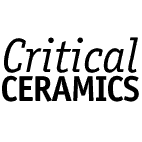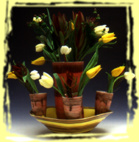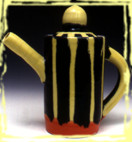Click to find out more...
Show your support by visiting our sponsor...




Flower Vase, 1998


Tumblers, 1997


Teapot, 1997
Alec Karros has been a utilitarian potter since graduating from the Rhode Island School of Design with a Master of Fine Arts. In addition to his studio work, Alec has taught for more than a dozen years including The University of the Arts in Philadelphia, SUNY Oswego (New York), and the University of Colorado at Boulder. Finally, Alec is invited to teach a number of studio workshops each year. Critical Ceramics spoke with Alec Karros during a lull in the action at Haystack.
CC: Where’s your home and studio?
AK: I’ve got my home and studio in Lebanon, New Jersey. It’s about halfway between New York City and Philadelphia.
CC: Is there enough of a market there?
AK: Well, yes. I get lots of visitors from both cities and, in general, I think there is a market right now for well designed handmade pottery.
CC: Is that different from when you started?
AK: The problem now is that it’s a market driven market. There’s very little fine art market for functional pottery these days. The gallery system is virtually nonexistent. Most places that call themselves galleries are glorified gift shops. No place is showing good functional pottery and treating it as art.
CC: How do you differentiate between product and art?
AK: When you’re dealing with bottom line... when you’re dealing with the lowest common denominator. The implication is, “if it doesn’t sell, it’s no good.” So, it’s very hard for thoughtful functional potters to find a niche.
CC: What about the big craft shows like Philadelphia and the Smithsonian?
AK: They have their quirks. They’re probably the only viable alternatives, but there’s only fifteen or twenty potters in each show, so it’s a very limited market.
CC: Tell us something more about the progression you’ve gone through.
AK: For me, my beginnings were academic. I taught for a number of years. For the last five, I’ve been in my studio full time just making pottery. I’ve made an okay living and I think I’ve made good pots. Last year, I took a sabbatical replacement job at The University of the Arts. This year, I’m going to stay on half time. So, I think that the viable alternative, if I want to continue to make good pots and not be burned out by the marketplace, is to find a balance between teaching and making pots in the studio, neither by themselves is entirely satisfactory.
CC: Intellectually satisfactory? Financially satisfactory?
AK: Intellectually satisfactory. By itself, either alternative could be financially satisfactory. Of course, I didn’t get into this to get rich! I’m finding that this combination of studio and teaching is working well for me. The market isn’t burning me out and academia isn’t removing me from practice. I think a lot of academia is self-indulgent pottery made for ourselves to look at and arcanely discuss.
CC: If one is an academic first and a potter second, as many teachers have been over the years, how does one transition into becoming an active potter first and an academic second?
AK: Well, there certainly is an educational component to becoming a studio potter. I’ve had to educate the market to accept my work. To accept the work as not being gift ware. I also think that when one makes functional pots, there’s a natural connection with market. My pots need to go somewhere and be used. They get better through use.
CC: The individual pots or your body of work as a whole become better?
AK: The individual pot. Through that tactile connection of use they fulfill their mission. I hope they’re good anesthetically. I hope they’re good technically. In the end, I really want them to come alive through use. When the user makes that tactile connection, the pot is totally fulfilled. So, market is really important because people have to have my pots for all of this to happen.
CC: What’s driving today’s market?
AK: There’s a lot of money now available to buy high end objects. Not pottery as utilitarian object, but pottery as decorative object. This trend is in the vein of the decorative arts tradition of status object. It says, “you have taste and style and money.” In the end, these pieces are devoid of any experience. They’re strictly visual.
CC: So, you’re not making teapots to sit on a shelf?
AK: No. No. As a result, I make lots of dinnerware because dinnerware gets used all the time. I make few teapots because they don’t get used very often. Most of what I make are things that I use everyday. Right now, I’m making a lot of vases - multi-part vases. My wife has discovered a second avocation as a gardener. As a result, we’re doing lots of flowers around our house. The vases are completed by being filled with flowers. I think it’s great.
CC: How do you critique your own work as you make it?
AK: That’s a fair question, but it’s a hard one. For one thing, I hope that the work is not repetitive more than it needs to be. Within the context of use, I change form a little bit each time,or change the way I’m throwing, or develop my color sense. I hope the pots stay fresh and energetic. I know that sounds limpidly humanist, but it’s true.
CC: When you make pots for others, does your criteria for good work change?
AK: No. I just don’t do it, if I don’t agree with it.
CC: Certainly the customer brings ideas and demands to you?
AK: Yes, but generally they bring out or make clear something that I have already done or hinted at. For example, I just completed a large dinnerware set in lavender and dark green. The customer had seen this color combination on a single cup and saucer I had used for a color test. It wasn’t something I’d normally do.
There’s a lot of education for me from the public. Academically, we teachers don’t get educated back except from the already initiated who are willing to discuss any arcane detail. So, the potter’s interplay with user, market, audience is really important. I get that through selling my pots out of the studio. In fact, I’m selling more and more right out of the studio. Sales have spiraled upward by word of mouth. As a potter, this may be the way to operate. Someone like Clary Illian may not be wrong in this way. By staying in one place a long time, one can develop a local market. And this goes back to one of the original roles of potters - being the local potter making the work for local people as opposed to trying to be the hot shot academic big wig!
CC: But you’ve already said that academia is important...
AK: Oh, without a doubt. For me, teaching and being in that environment is feeding an intellectual, theorizing need. I’ve been talking about “dialectic process” and “cellular structures” as form language here in the workshop; these are things I’m not going to get to talk about in the marketplace.
CC: How do you coach your students about their options outside of the closed academic environment?
AK: That’s a hard question. I certainly don’t want to address it too directly with undergraduate students. First and foremost, they need to know how to make pottery well. In a design sense. In a history of ceramics sense. In an objective functional sense. These things take up the full four years. It’s not that I want them to be devoid of knowledge of the marketplace, but I don’t want to make it an emphasis. The marketplace should not be a defining factor in education. In the junior year at The University of the Arts, we do a project addressing “audience” which is our more conceptual way to say “market”.
My biggest feeling about teaching students pottery is that I want them to understand it abstractly, conceptually. I think we have a tendency to teach by example, “here’s a good pot, copy it.” If the students don’t understand the deeper “why”, then they’re never going to get beyond copying. I mean, think about it. Technique in pottery is pretty elementary. Once you know how to throw and attach things, the rest should come out of your individual needs, but not the need to amass a bag of tricks. I guess we’re teaching pottery okay in the U.S.
CC: Why just okay?
AK: I think we’ve still based a lot on existing academic precedent rather than real investigation into the conceptual roots of pottery. The wood firing thing, for example, is a process oriented mode that isn’t based on a deep analytical analysis of pottery form, historical development, and how these things can be used in the twentieth century by contemporary potters. I think that’s what’s at issue.
CC: As a teacher, how does one avoid having students only amass a bag of tricks?
AK: You get into the “why’s” and “what’s” of pottery right away. Lots of slides. Tons of talk about pottery and how forms developed. Deal back and forth between function as object � “teapot”, “pitcher”, et cetera � and pottery as abstract form that relates to universal form structure � the golden rectangle, the Fibonacci progression, and so on.
CC: After school, then, how does one continue?
AK: More than anything, I think it’s very important not to be a slave to the market for the first few years. There’s still a lot of work to be done with yourself in the studio.
CC: But you’ve got to get your pots out there...
AK: I know. It’s a hard gig. Entering shows is good. Find work that supports you enough and allows you to continue making your work without the commercial pressure. Find a place where you can work and scrape by as you develop. Then you won’t be defined by the demands of the marketplace. That’s the key, not to be defined by it. Students should expect to do five or ten years of this after school. I know it’s not very promising, but that’s just the way it is.
CC: Does everything you’ve just said about pottery apply to ceramic sculpture?
AK: Sure. I think the biggest issue in clay sculpture is that in many instances it is primarily technique driven, less content driven. I see a lot of clay sculpture that is really well made, and it may be interesting formally, but is has no conceptual basis. It seems to me that sculpture has to start with content and then move to technique. So, I think that much of today’s clay sculpture is conceptually weak. Now, granted I haven’t seen it all...
CC: You’re describing an exact opposite approach to making sculpture than pottery?
AK: In a way, yes. Because potters start with technique over content and then find a way to individualize it. Ceramic sculpture is really hard because it comes out of a material background. Jeanne Jaffe does it well, but when she’s needed to she’s moved onto other materials. Doug Jeck does it well. It’s not the material that is or should be at issue; at issue should be one’s approach to making sculpture. The content of the sculpture has to supersede any material issue. You can use the material and it can be part of the content, but to be successful, material can’t be the only or greatest bit of content.
I rarely see any clay sculpture that “wow’s” me beyond that which is some well designed ceramic work. When Viola Frey first made her huge figurines, it worked. The reference to material, domesticity, tchachkas. They were just right. Or Arneson making his heroic heads out of terra cotta instead of marble! They were self-depricating and then sly while using all the conventions like plinth and so on. It just worked! Clay added to those sculptures tremendously and was inherent in the content. Their content was improved because they were made out of clay. And all the material manipulation increased the intensity of them. They were just right. I haven’t seen things that exciting for awhile.
On a conceptual basis, whether we’re discussing pottery or sculpture, I’m against aestheticism. Don’t get me wrong, I have nothing against a beautiful object, but beauty must occur as a consequence of something greater. For instance, I believe that handmade utilitarian ware feeds a much needed experiential hunger.
CC: Is pottery loosing ground as a utilitarian, experiential object?
AK: Yes. When I go to these craft shows, ninety percent of what I see is bastardized market drive ware that’s falling into utilitarian dogma without any real purpose. At the same time, we’re loosing ground academically because we’re making stylized work based on what other academics have made. Thus, acceptance into the club is automatic. This is a way of getting into galleries, building a portfolio, and being promoted to the next level of professor.
CC: So, what do we have to look forward to?
AK: Actually, I think pottery could be pretty good right now. We’ve got to look at new areas. I don’t particularly like Jonathan Adler’s pots, but I don’t think we have, as a field, ever dealt with the issue of potters as industrial designers and hand makers. Where do the two meet? I think there might be some interesting things to be found there. It’s amazing that slip casting gets looked down at. It’s totally, totally, out of the loop everywhere. In terms of practicing artists, Andy Martin would be the exception.
CC: Ignoring one whole area like that sure isn’t fair to the student.
AK: You’re right. One thing that I am encouraged about is that the wood fire craze seems to have peaked. There’s a little more acceptance now of non-atmospheric fired, non-Leach/Hamada based work. That’s not to say that someone like Michael Simon doesn’t make good pots; he makes really good pots. It’s just that there should be more alternatives today to the traditional pottery cartels.
CC: How does the field of ceramic art move forward?
AK: I believe that Modernism has to work in there somewhere. It failed in a way, but there are some kernels that are worth reexamining. We need to be pushing really well designed objects that are handmade and that do not simply replicate history. If we could blend Modernists like Russell Wright with the Leach/Hamada tradition in order to make modern pots that synthesize all those things, we would be in good shape. That’s exactly right on what I want to do.


Dinnerware, 1996


Covered Dish, 1996